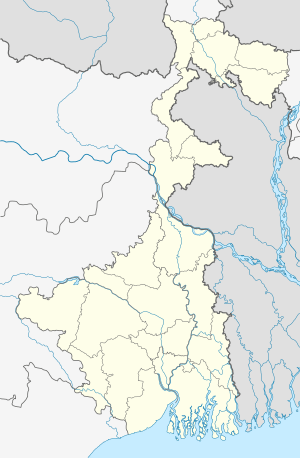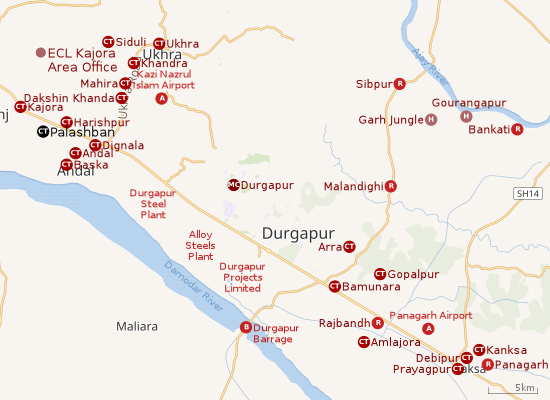Palashban
Palashban is a census town in the Andal CD block in the Durgapur subdivision of the Paschim Bardhaman district in the Indian state of West Bengal.
Palashban | |
|---|---|
Census Town | |
 Palashban Location in West Bengal, India  Palashban Palashban (India) | |
| Coordinates: 23.584678°N 87.163186°E | |
| Country | |
| State | West Bengal |
| District | Paschim Bardhaman |
| Area | |
| • Total | 2.83 km2 (1.09 sq mi) |
| Population (2011) | |
| • Total | 4,811 |
| • Density | 1,700/km2 (4,400/sq mi) |
| Languages* | |
| • Official | Bengali, Hindi, English |
| Time zone | UTC+5:30 (IST) |
| PIN | 713424 |
| Telephone/STD code | 0341 |
| Vehicle registration | WB |
| Lok Sabha constituency | Asansol |
| Vidhan Sabha constituency | Raniganj |
| Website | paschimbardhaman |
Geography
 |
| Cities and towns in the southern and eastern portions of Durgapur subdivision in Paschim Bardhaman district MC: Municipal Corporation, CT: census town, R: rural centre, A: airport, B: barrage, H: historical site Owing to space constraints in the small map, the actual locations in a larger map may vary slightly |
Location
Palashban is located at 23°35′05″N 87°09′47″E.
The Asansol-Durgapur region is composed of undulating laterite soil. This area lies between two mighty rivers – the Damodar and the Ajay. They flow almost parallel to each other in the region – the average distance between the two rivers is around 30 km. For ages the area was heavily forested and infested with plunderers and marauders. The discovery of coal in the 18th century led to industrialisation of the area and most of the forests have been cleared.[1]
Urbanisation
According to the 2011 census, 79.22% of the population of Durgapur subdivision was urban and 20.78% was rural. Durgapur subdivision has 1 municipal corporation at Durgapur and 38 (+1 partly) census towns (partly presented in the map alongside; all places marked on the map are linked in the full-screen map).[2]
Andal, a part of Andal (gram), Dignala, Palashban and Baska lying south of National Highway 19 (old numbering NH 2)/ Grand Trunk Road form a cluster of census towns. This cluster is linked to a cluster of census towns located north of NH 19.[3]
Demographics
According to the 2011 Census of India, Palashban had a total population of 4,811, of which 2,531 (53%) were males and 2,280 (47%) were females. Population in the age group 0-6 years was 478. The total number of literate persons in Palashban was 3,580 (82.62% of the population over 6 years).[4]
*For language details see Andal (community development block)#Language and religion
As of 2001 India census,[5] Palashban had a population of 4,856. Males constitute 53% of the population and females 47%. Palashban has an average literacy rate of 75%, higher than the national average of 59.5%: male literacy is 84%, and female literacy is 66%. In Palashban, 10% of the population is under 6 years of age.
Infrastructure
According to the District Census Handbook 2011, Bardhaman, Palashban covered an area of 2.83 km2. Among the civic amenities, the protected water-supply involved service reservoir, tube well, borewell. It had 384 domestic electric connections and 27 road lighting (points). Among the medical facilities, it had 1 hospital, 1 charitable hospital/ nursing home, 7 medicine shops. Among the educational facilities it had was 1 primary school, the other school facilities were available at Andal located nearby. Among the important commodities it produced were bricks.[6]
Economy
It is in the heart of the coal mining zone.[7]
Education
Palashban has three primary and one higher secondary schools.[8]
Rahmatnagar Iqbal Academy is an Urdu-medium coeducational institution established in 1978. It has facilities for teaching from class V to class XII. The school has 15 computers, a library with 1,000 books and a playground. [9]
Madanpur Mahesh Vidyamandir is a Bengali-medium coeducational institution established in 1957. It has facilities for teaching from class V to class X.[10]
References
- Chattopadhyay, Akkori, Bardhaman Jelar Itihas O Lok Sanskriti (History and Folk lore of Bardhaman District), (in Bengali), Vol I, pp. 14-15, Radical Impression. ISBN 81-85459-36-3
- "District Statistical Handbook 2014 Burdwan". Table 2.2, 2.4(a). Department of Statistics and Programme Implementation, Government of West Bengal. Retrieved 15 September 2018.
- "District Census Handbook Bardhaman, Series 20, Part XII A, Census of India 2011" (PDF). Map of Ondal CD Block, page 229. Directorate of Census Operations, West Bengal. Retrieved 16 September 2018.
- "2011 Census – Primary Census Abstract Data Tables". West Bengal – District-wise. Registrar General and Census Commissioner, India. Retrieved 20 February 2017.
- "Census of India 2001: Data from the 2001 Census, including cities, villages and towns (Provisional)". Census Commission of India. Archived from the original on 16 June 2004. Retrieved 1 November 2008.
- "District Census Handbook Barddhaman, Census of India 2011, Series 20, Part XII A" (PDF). Section II Town Directory, Pages 1179-1210; Statement I: Status and Growth History, Page 1179; Statement II: Physical Aspects and Location of Towns, Page 1188; Statement III: Civic and other Amenities, Page 1191; Statement IV: Medical Facilities, Page 1196; Statement V: Educational, Recreational and Cultural Facilities, Page 1200; Statement VI:Industry and Banking, Page 1209:. Directorate of census Operations V, West Bengal. Retrieved 14 May 2020.CS1 maint: extra punctuation (link)
- Chattopadhyay, Akkori, p. 666
- 7th All-India School Education Survey 2003 Archived 2007-09-27 at the Wayback Machine
- "Rahmatnagar Iqbal Academy". Schools.org.in. Retrieved 14 June 2020.
- "Madanpur Mahesh Vidyamandir". Schools.org.in. Retrieved 14 June 2020.